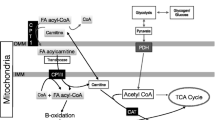Abstract
Fatty acids are the most abundant source of endogenous energy substrate. They can be mobilized from peripheral adipose tissue and transported via the blood to active muscle. During higher intensity exercise, triglyceride within the muscle can also be hydrolyzed to release fatty acids for subsequent direct oxidation. Control of fatty acid oxidation in exercise can potentially occur via changes in availability, or via changes in the ability of the muscle to oxidize fatty acids. We have performed a series of experiments to distinguish the relative importance of these potential sites of control.
Access this chapter
Tax calculation will be finalised at checkout
Purchases are for personal use only
Preview
Unable to display preview. Download preview PDF.
Similar content being viewed by others
References
Dagenais, G.R., R.G. Tancredi, and K.L. Zierler. Free fatty oxidation by forearm muscle at rest, and evidence for an intramuscular lipid pool in the human forearm. J. Clin Invest. 58: 421–431, 1986.
Fritz, I.B. Action of carnitine on long chain fatty acid oxidation by liver. Am. J. Physiol. 197: 297–304, 1959.
Hurley, B.F., P.M. Nemeth, W.H. Martin III, J.M. Gagbert, G.P. Dalsky, and J.O. Holloszy. Muscle triglyceride utilization during exercise:effect of training. J. Appl. Physiol. 60(2): 562–567, 1986.
Klein, S., E.F. Coyle, and R.R. Wolfe. Effect of exercise on lipolytic sensitivity in endurance-trained athletes. J. Appl. Physiol. 78(6):2201–2206, 1995.
Klein, S., E.F. Coyle, and R.R. Wolfe. Fat metabolism during low-intensity exercise in endurance-trained and untrained men. Am. J. Physiol. 267 (Endocrinol. Metab. 30):E934-E940, 1994.
Pande, S.V. A mitochondrial carnitine acyltransferase transolcase system. Proc. Natl. Acad. Sci. USA 72: 883–887, 1975.
Romijn, J.A., E.F. Coyle, J. Hibbert, and R.R. Wolfe. Comparison of indirect calorimetry and a new breath 13C/12C ratio method during strenuous exercise. Am. J. Physiol. 263 (Endocrinol. Metab. 28):E64-E71, 1992.
Romijn, J.A., E.F. Coyle, L.S. Sidossis, A. Gastaldelli, J.F. Horowitz, E. Endert, and R.R. Wolfe. Regulation of endogenous fat and carbohydrate metabolism in relation to exercise intensity and duration. Am. J. Physiol. 265 (Endocrinol. Metab. 28):E380-E391, 1993.
Romijn, J.A., E.F. Coyle, X-J. Zhang, L.S. Sidossis, and R.R. Wolfe. Relationship between fatty acid delivery and fatty acid oxidation during strenuous exercise. J. Appl. Physiol. 79: 1939–1945, 1995.
Romijn, J.A., S. Klein, E.F. Coyle, L.S. Sidossis, and R.R. Wolfe. Strenuous endurance training increases lipolysis and triglyceride-fatty acid cycling at rest. J. Appl. Physiol. 75(1): 108–113, 1993.
Sidossis, L.S., A.R. Coggan, A. Gastaldelli, and R.R. Wolfe. Pathway of Free Fatty Acid oxidation in human subjects: implications for tracer studies. J. Clin. Invest. 95: 278–284, 1995.
Sidossis, L.S., A. Gastadelli, S. Klein and R.R. Wolfe. Regulation of plasma FFA oxidation during low and high intensity exercise. Am. J. Physiol. 272, E1065–E1070, 1997.
Sidossis, L.S., R.R. Wolfe, and A.R. Coggan. Regulation of fatty acid oxidation in untrained versus trained men during exercise. Am. J. Physiol. 274: E510–E515, 1998.
Wolfe, R.R. Radioactive and Stable Isotope Tracers In Biomedicine: Principles and Practice of Kinetic Analysis. Wiley-Liss, New York, 1992, 475 pages.
Wolfe, R.R. and E.J. Peters. Lipolytic response to glucose infusion in human subjects. Am. J. Physiol. 252 (Endocrinol. Metab. 15):E218-E223, 1987.
Wolfe, R.R., S. Klein, F. Carrari, and J.M. Weber. Role of triglyceride-fatty acid cycle in controlling fat metabolism in humans during and after exercise. Am. J. Physiol. 258: E382–E389, 1990.
Author information
Authors and Affiliations
Editor information
Editors and Affiliations
Rights and permissions
Copyright information
© 1998 Springer Science+Business Media New York
About this chapter
Cite this chapter
Wolfe, R.R. (1998). Fat Metabolism in Exercise. In: Richter, E.A., Kiens, B., Galbo, H., Saltin, B. (eds) Skeletal Muscle Metabolism in Exercise and Diabetes. Advances in Experimental Medicine and Biology, vol 441. Springer, Boston, MA. https://doi.org/10.1007/978-1-4899-1928-1_14
Download citation
DOI: https://doi.org/10.1007/978-1-4899-1928-1_14
Publisher Name: Springer, Boston, MA
Print ISBN: 978-1-4899-1930-4
Online ISBN: 978-1-4899-1928-1
eBook Packages: Springer Book Archive



